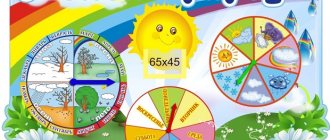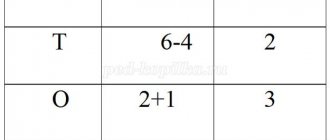The meaning of the word "card index"
This term was coined by the ancient Greeks. Translated from their language, it meant “a place for storing sheets of papyrus.” Over the millennia that have passed since then, the semantics of the word “card file” has not changed much. And today this is the name given to a collection of cards with data laid out in a certain order.
The purpose of filing cabinets is to preserve and organize information. And also make it easier to find. Therefore, the cards are arranged according to the selected criterion. Most often in alphabetical order. Less often - by year, address, number, topic, last name, etc.
Also, a filing cabinet is also specialized furniture for storing the above-mentioned collections. Sometimes this is the name given to the room or department where they are located.
In fact, over the millennia since the emergence of this concept, only the material of the cards has changed in its structure and meaning from papyrus to cardboard.
Didactic games according to Federal State Educational Standards in the senior group
In the senior group, educational and cognitive games, familiarity with nature, surrounding objects, phenomena and properties of objects are required. We must not forget about outdoor activities and general physical development. It is important to continue to acquaint preschoolers with emotions, norms of communication and social interaction, teach them productive teamwork, clear expression of thoughts and constructing a conversation.
A big secret
For a group game, prepare a box, put small objects or cards depicting them in it. Seat children at a distance from each other.
Approach each player in turn and offer to take an item out of the box without looking inside. The pulled out item remains secret; the player must not show it to his comrades. The players’ task is to find out by any verbal means what this secret thing is. Can:
- ask the holder of the item leading questions;
- persuade, beg the player to reveal the secret;
- offer a gift for revealing a secret;
- offer to reveal your secret in return.
It is important to ensure that players do not deceive each other. The game ends when the last player tells his secret. If a player becomes stubborn and refuses to reveal a secret, you need to gently push him to change his behavior, instill in him the importance of being open, friendly, and sociable.
Show me the word
The game task is to depict a given word through facial expressions and body movements. The presenter says, for example, “little bear.” Then he calls one of the players and asks him to imitate what was said. Then he pronounces another word - “loves”, calls the second participant, asks him to depict this verb. The rest of the players say in chorus what their comrades are pretending to say: “The little bear loves...”. Next, the presenter asks you to come up with a third word that will complete the phrase. Players name different options: honey, berries, sleep, play.
Group items
For the game, prepare about 20-25 items and place them on the table. Invite students to divide them into groups according to quality characteristics:
- large;
- small;
- wooden;
- plastic;
- metal;
- edible;
- inedible;
- colored;
- transparent.
Remember the place
Children are seated in different places in the playroom. Each player remembers where he sits. To do this, he can use landmarks: nearby objects, toys, furniture, interior elements.
Turn on the music. The players jump up, run around the hall, and dance. When the music is interrupted, the children must remember where they were sitting and take their place. At the second stage, the game can be complicated: children should not sit in their original place, but move a few steps along the movement of the arrow.
Talking portrait
The game teaches the skill of a coherent story. To carry it out, prepare portraits in which the people depicted express different emotions and are in different settings. Invite the students to take turns telling about themselves on behalf of the depicted character.
To play you need a regular envelope. Children stand in a circle, choose one of the players to be the “postman”, he becomes and gives an envelope, for example, to Misha. He says: “The letter comes from Misha Katya.” Children standing in a circle quickly pass the envelope to each other until it falls into Katya’s hands. The task of the “postman” is to have time to snatch the “letter” before it reaches the “addressee”. When he succeeds, the player from whose hands the envelope was snatched becomes the “postman”.
Card index in the computer age
Before the invention of computers, which today we more often call computers, the main carrier of information was paper. Moreover, even the invention of photography could not supplant it. Therefore, for many centuries, card indexes did not change their appearance.
Today, there is no longer a need for them in the form they existed. Even in the most backward countries, paper file cabinets are confidently being replaced by computer information databases. That is, they evolve from a physical form to a digital one.
This happens because in the memory of a laptop, tablet or even mobile phone, you can store as much information as previously fit in several rooms filled to the brim with filing cabinets. In addition, the process of searching for the required file now takes seconds, while with paper cards it took minutes and sometimes hours.
Certificate from the bank about the absence of a card index (sample)
Help will be needed in several cases. Very often it is required to confirm the financial stability of the company. This need arises when receiving loans and various subsidies.
When receiving loans, a certificate is required to confirm the unquestioning execution of payments on upcoming loans.
When applying for payments of various subsidies and allowances. In this case, thanks to the certificate, the authorities issuing funds and issuing subsidies and additional payments must be sure that the allocated money will not be used to pay for orders in the card index, but will be sent to their destination.
An application for a certificate is submitted in free form on behalf of the management of the legal entity. After submitting the application, the bank reviews it and issues a certificate.
Sample application for submission to the ban :
LLC "Mimino" Registered at the address: 976543 Moscow, Pushkin Avenue, building 134, building 4, room 5. Contact numbers: 8 (567) 453636,. IIN: 674532467467
To the Sberbank branch in Moscow and the Moscow region No. 356774
We request that our company be issued a certificate confirming the absence of a card index regarding the current account issued to our company under number 453465789064577. The certificate is required to be submitted to VTB Bank for processing and issuing a cash loan secured by an existing business.
CEO. V. Z. Ivanov 12/13/2020
Example of a bank statement
Medical databases
If, with the advent of electronic books, people go to the library much less often, preferring to download everything and read on a computer, then a medical file is something that one has to deal with against one’s own will.
In any medical institution (no matter public or private), each patient has his own card. It stores all the secrets about his health (symptoms, test results, treatment, doctor’s orders, extracts from the medical history).
It is interesting that although all these “cards” are in practice more like brochures or small books, they continue to bear their traditional name. The thing is, this system initially really consisted of cardboard cards with data, after which this document is named.
Like all other filing systems, medicine is now widely computerized in more developed countries. We are still just getting there. However, there are already several programs adapted to our realities for maintaining a database of patients, recording the services provided to them in hospitals, clinics and other medical institutions. True, they are specialized for paid clinics, where they are used most often.
The order of payments according to the card index
Since there is a certain order, all payment orders regarding any legal entity are executed only in accordance with it. If there are enough funds in the settlement account and only confirmation is required for payment, payments will be made according to the date.
But if there is not enough money, the queue changes in the order:
- Alimony and payment of compensation for human life and health;
- All calculations that relate to the payment of wages and other settlements with personnel and employees of the organization;
- Payments to government agencies. Such as taxes, social contributions and others;
- Other assignments. When it comes to this category, they are considered in the order received.
If there are several orders in each item, they are also considered in order of date of receipt.
Card file of arbitration cases
The judicial system has mastered new trends much faster than the medical system. At the moment, in most countries of the world, computer databases are being created that contain information on cases that are or have been before arbitration courts of all levels and entities.
In the Russian Federation this is the Card Index of Arbitration Cases. It is a website kad.arbitr.ru, where, using various search parameters, you can find all the necessary data about the court decision, if for some reason they are not classified. This resource inherited its name from a system used in the pre-computer era. While in the same Ukraine, a site with such data is called not a “card index”, but a “register” (“Unified State Register of Ship Decisions”).
And also about the law enforcement system. As is known, from the moment of its formation, all countries of the world began to keep records of persons who had previously committed crimes or were suspected of them.
Today, all this information is no longer stored in dusty folders, but has been digitized and entered into computer databases.
In the Russian Federation, the “Card Index” program has been developed to store information from the forensic expert department of the Ministry of Internal Affairs and about registered persons. We can assume that its name is another way of interpreting the term in question.
Concept
A card index is a record of documents arranged in alphabetical order. There may also be a distribution by deadlines and topics. Thanks to the fact that everything is located in one department of the enterprise, finding any information will not be difficult.
What is a card index in a library? These are catalogs that allow you to quickly find books of interest, because all readers come to receive specific information. Without them, it would be difficult to navigate any library.
Card index of games in preschool education
The human brain absorbs information best when it is relaxed. Therefore, in preschool institutions, the most effective teaching method is games. With their help, children learn rules of behavior and hygiene, try different professions and socialize much faster.
According to the requirements of the modern education system, data about such games is recorded on special cards. They contain not only the name, but also the purpose and rules.
The complexity and desired outcome of the game varies according to the theme and age of the children. These are the main criteria on the basis of which a general card file is formed.
In the group where all these games are held, their results are strictly monitored. Particular attention is paid to the skills that children should develop. Based on their results, a conclusion is drawn about the effectiveness/ineffectiveness of the game and the advisability of its further use.
Card indexes collected in this way are published in pedagogical journals (as an example) or published on specialized websites on the Internet.
Middle group. Junior preschool age. Children 4 - 5 years old
Card index of games to develop a sense of empathy in the middle group “My Palm”
(for
children 4-5 years old ) Objectives: - stimulation of self-knowledge; - formation of an idea of one’s individuality, self-acceptance through contact with one’s own body. Several people take part in the game. They are located on the carpet. Pleasant music comes on...
Card index of didactic games for the development of thinking of children of primary preschool age Methodological development on the topic: “ Card index of didactic games for the development of thinking of children of primary preschool age” Explanatory note Topic: “ Card index of didactic games for the development of thinking of children of primary preschool age.” Goal for the teacher: development of thinking...
Banking industry
What is a card index in a bank? This term implies accounting for payment documents that the bank has not fulfilled. The institution keeps them under control. The file cabinet can be of different types, depending on the reasons for unpaid obligations.
These may be orders that were not executed due to lack of funds. Then the employee registers the document in electronic and paper form. This payment will be in an off-balance sheet account. The account owner is informed that the document has been queued. Once received, the funds are credited to the desired account. The file cabinet stores documents that require consent to perform a payment transaction, as well as those that are awaiting their turn.
The presence of a file cabinet indicates that the company has an unstable financial position. If the account owner does not have it, then the bank offers a line of credit or an additional one. financing.
The sequence is the order in which payment orders are executed. It is approved by law. Documents are not processed ahead of the queue. If the account has the required amount, then everything goes by date. If the necessary funds are not available, the following queue is established:
- execution of orders for damage compensation;
- payment of salaries, sick leave, vacations;
- tax payments;
- sending money to funds;
- other requirements.
Document storage rules
The archive is maintained by a special employee who works on the basis of a job description. The employee ensures the reception, recording and storage of documentation. It carries out information and reference activities, as well as organizational and methodological ones.
At each enterprise, the archive is located in a separate room. Only as an exception, racks, cabinets, and safes are used that perform the function of preserving documentation. Their shelf life is determined to be 3 years, but it can be reduced.
After this period has expired, it is determined whether the document will be used or archived forever. There is also a destruction option. What exactly needs to be done is decided on the basis of an expert commission.
Directory types
The card file includes many catalogs, which may differ in purpose, coverage of the fund, grouping method, technology of creation and use.
If we consider the purpose, then catalogs are for readers and for service purposes. They contain, for example, information of interest to readers. Based on the coverage of collections, catalogs can include useful information about institutions, as well as about specific library departments.
According to the grouping method, cards are:
- alphabetical;
- systematic.
The first is presented in the form of a catalog where the data is listed in alphabetical order. To quickly find the book you need, you need to find the author's name or the title of the work. Using such a catalog is very convenient.
A systematic catalog is a catalog in which information is located by field of knowledge. For this purpose, the principles of library and bibliographic classification are used, which prescribe the rules for grouping information. Considering the type of creation and use, file cabinets can be traditional or electronic.
Library
The literature card file occupies an important place in an educational institution. Readers receive information about it thanks to:
- visual information;
- events, conversations, excursions;
- days of bibliography;
- publication of manuals;
- use of forms and methods of library activities.
The system of catalogs and cards in the library is managed through planning, coordination, and control. The work of employees in this area consists of drawing up plans, developing documentation, and monitoring completed activities. Each library card is subject to maintenance and editing, for which employees are responsible according to their job description.






